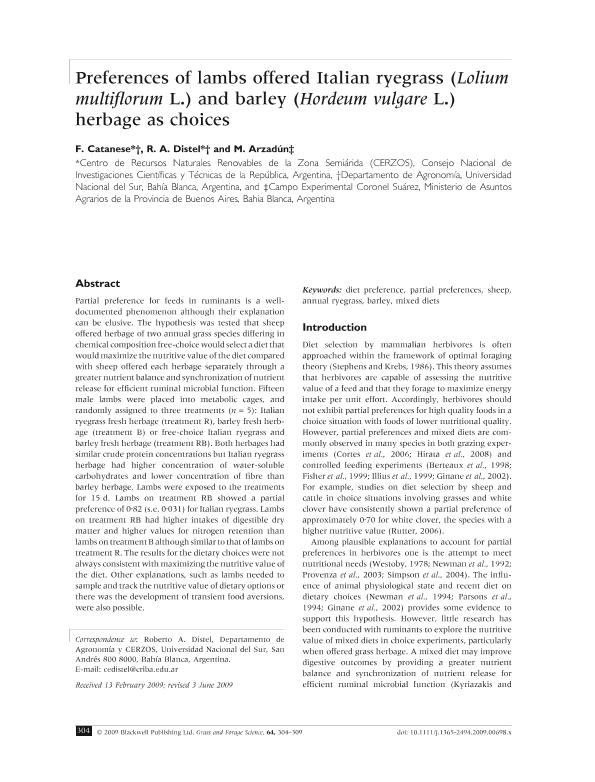Mostrar el registro sencillo del ítem
dc.contributor.author
Catanese, Francisco Hernan

dc.contributor.author
Distel, Roberto Alejandro

dc.contributor.author
Arzadun, Mariela

dc.date.available
2017-10-19T18:33:37Z
dc.date.issued
2009-08
dc.identifier.citation
Catanese, Francisco Hernan; Distel, Roberto Alejandro; Arzadun, Mariela; Preferences of lambs offered Italian ryegrass (Lolium multiflorum L.) and barley (Hordeum vulgare L.) herbage as choices; Wiley; Grass and Forage Science; 64; 3; 8-2009; 304-309
dc.identifier.issn
0142-5242
dc.identifier.uri
http://hdl.handle.net/11336/26830
dc.description.abstract
Partial preference for feeds in ruminants is a welldocumented phenomenon although their explanation can be elusive. The hypothesis was tested that sheep offered herbage of two annual grass species differing in chemical composition free-choice would select a diet that would maximize the nutritive value of the diet compared with sheep offered each herbage separately through a greater nutrient balance and synchronization of nutrient release for efficient ruminal microbial function. Fifteen male lambs were placed into metabolic cages, and randomly assigned to three treatments (n = 5): Italian ryegrass fresh herbage (treatment R), barley fresh herbage (treatment B) or free-choice Italian ryegrass and barley fresh herbage (treatment RB). Both herbages had similar crude protein concentrations but Italian ryegrass herbage had higher concentration of water-soluble carbohydrates and lower concentration of fibre than barley herbage. Lambs were exposed to the treatments for 15 d. Lambs on treatment RB showed a partial preference of 0Æ82 (s.e. 0Æ031) for Italian ryegrass. Lambs on treatment RB had higher intakes of digestible dry matter and higher values for nitrogen retention than lambs on treatment B although similar to that of lambs on treatment R. The results for the dietary choices were not always consistent with maximizing the nutritive value of the diet. Other explanations, such as lambs needed to sample and track the nutritive value of dietary options or there was the development of transient food aversions, were also possible.
dc.format
application/pdf
dc.language.iso
eng
dc.publisher
Wiley

dc.rights
info:eu-repo/semantics/openAccess
dc.rights.uri
https://creativecommons.org/licenses/by-nc-sa/2.5/ar/
dc.subject
Diet Preference
dc.subject
Partial Preferences
dc.subject
Annual Ryegrass
dc.subject
Barley
dc.subject
Sheep
dc.subject
Mixed Diets
dc.subject.classification
Otras Producción Animal y Lechería

dc.subject.classification
Producción Animal y Lechería

dc.subject.classification
CIENCIAS AGRÍCOLAS

dc.title
Preferences of lambs offered Italian ryegrass (Lolium multiflorum L.) and barley (Hordeum vulgare L.) herbage as choices
dc.type
info:eu-repo/semantics/article
dc.type
info:ar-repo/semantics/artículo
dc.type
info:eu-repo/semantics/publishedVersion
dc.date.updated
2017-10-09T15:30:00Z
dc.journal.volume
64
dc.journal.number
3
dc.journal.pagination
304-309
dc.journal.pais
Estados Unidos

dc.journal.ciudad
Hoboken
dc.description.fil
Fil: Catanese, Francisco Hernan. Consejo Nacional de Investigaciones Científicas y Técnicas. Centro Científico Tecnológico Conicet - Bahía Blanca. Centro de Recursos Naturales Renovables de la Zona Semiárida. Universidad Nacional del Sur. Centro de Recursos Naturales Renovables de la Zona Semiárida; Argentina. Universidad Nacional del Sur. Departamento de Agronomía; Argentina
dc.description.fil
Fil: Distel, Roberto Alejandro. Consejo Nacional de Investigaciones Científicas y Técnicas. Centro Científico Tecnológico Conicet - Bahía Blanca. Centro de Recursos Naturales Renovables de la Zona Semiárida. Universidad Nacional del Sur. Centro de Recursos Naturales Renovables de la Zona Semiárida; Argentina. Universidad Nacional del Sur. Departamento de Agronomía; Argentina
dc.description.fil
Fil: Arzadun, Mariela. Provincia de Buenos Aires. Ministerio de Asuntos Agrarios; Argentina
dc.journal.title
Grass and Forage Science

dc.relation.alternativeid
info:eu-repo/semantics/altIdentifier/doi/http://dx.doi.org/10.1111/j.1365-2494.2009.00698.x
dc.relation.alternativeid
info:eu-repo/semantics/altIdentifier/url/http://onlinelibrary.wiley.com/doi/10.1111/j.1365-2494.2009.00698.x/abstract
Archivos asociados
